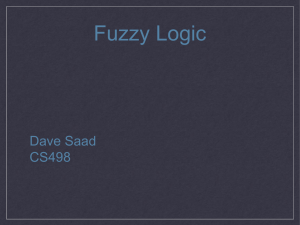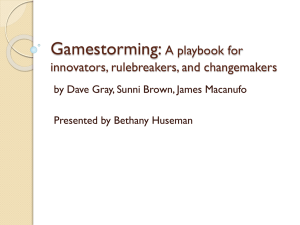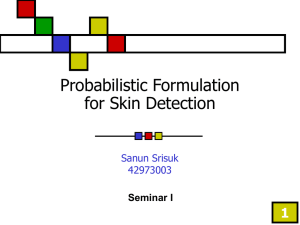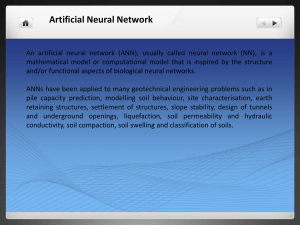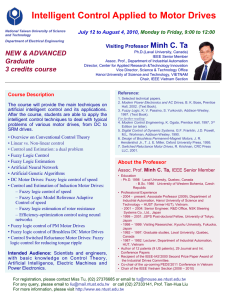Fuzzy Inference and Reasoning
advertisement
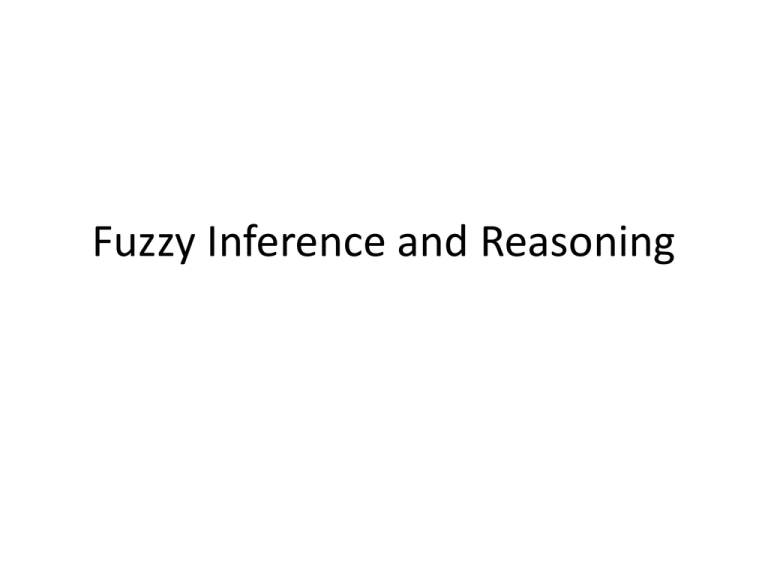
Fuzzy Inference and Reasoning
Proposition
2
Logic variable
3
Basic connectives for logic variables
(1)Negation
(2)Conjunction
4
Basic connectives for logic variables
(3) Disjunction
(4)Implication
5
Logical function
6
Logic Formula
7
Tautology
9
Tautology
10
Predicate logic
11
Fuzzy Propositions
• Assuming that truthand falsity are expressed
by values 1 and 0, respectively, the degree of
truth of each fuzzy proposition is expressed by
a number in the unit interval [0, 1].
Fuzzy Propositions
p : temperature (V) is high (F).
Fuzzy Propositions
p : V is F is S
•
•
•
•
V is a variable that takes values v from some universal set V
F is a fuzzy set onV that represents a fuzzy predicate
S is a fuzzy truth qualifier
In general, the degree of truth, T(p), of any truth-qualified
proposition p is given for each v e V by the equation
T(p) = S(F(v)).
p : Age (V) is very(S) young (F).
Representation of Fuzzy Rule
17
Representation of Fuzzy Rule
18
Fuzzy rule as a relation
If x is A, then y is B
x is A, y is B fuzzy predicatesA(x), B( y )
If A(x), thenB( y )
can be represented by relation
R( x, y ) : A(x) B( y )
R( x, y ) can be considereda fuzzy set with 2 - dim membershipfunction
R ( x, y ) f ( A ( x), B ( y ))
wheref is " fuzzy implication function", performsthe task
of transforming themembershipdegrees of x in A and y in B
into thoseof ( x, y ) in A B
19
Fuzzy implications
20
Example of Fuzzy implications
Let T and H be universeof temperatu
re and humidity,
and define variablest T and h H.
A " high", A T
B " fairly high", B H
t hen t herule can be rewrit t enas
R(t ,h) : If t is A, thenh is B
R(t ): t is A, R(h) : h is B
R(t ,h) : R(t ) R(h)
R(t ,h) A B A (t ) B (h) /(t , h)
21
Example of Fuzzy implications
R(t, h) A B A (t ) B (h) /(t , h)
h
t
20
30
40
20
50
70
90
0.1
0.2
0.2
0.1
0.5
0.6
0.1
0.5
0.7
0.1
0.5
0.9
22
Example of Fuzzy implications
When" temperature is fairlyhigh"or t is A' , A' T
We can use composition of fuzzy relations to find R(h)
R( h) R(t ' ) R C (t , h)
h
t
20
30
40
20
50
70
90
0.1
0.2
0.2
0.1
0.5
0.6
0.1
0.5
0.7
0.1
0.5
0.9
23
Representation of Fuzzy Rule
Single input and single output
Fact:
u is A '
: R(u)
Rule: If u is A then w is C : R(u, w)
Result: w is C '
: R( w) R(u) R(u, w)
Multiple inputs and single output
Fact:
u1 is A1' ' and u2 is A2' ' and ... and un is An' '
Rule: If u1 is A1 and u2 is A2 and ... and un is An then w is C
Result: w is C '
Multiple inputs and Multiple outputs
Fact:
u1 is A1' and u2 is A2' and ... and un is An'
Rule: If u1 is A1 and u2 is A2 and ... and un is An then w1 is C1 , w2 is C2 ,..., wm is Cm
Result: w1 is C1' , w2 is C2' ,..., wm is Cm'
24
Representation of Fuzzy Rule
Multiple rules
Fact : u1 is A' 1 and u2 is A' 2 and ... and un is A' n
Rule j : If u1 is A' 1 j and u2 is A' 2 j and ... and un is A' nj , then w1j is C'1j , w 2j is C' 2j , ..., w mj is C' mj
Result : w1 is C'1 , w 2 is C' 2 , ..., w m is C' m
25
Compositional rule of inference
The inference procedure is called as the “compositional rule of inference”. The
inference is determined by two factors : “implication operator” and
“composition operator”.
For the implication, the two operators are often used:
For the composition, the two operators are often used:
26
Representation of Fuzzy Rule
Fact:
u is A '
: R(u)
Rule: If u is A then w is C : R(u, w)
Result: w is C '
: R( w) R(u) R(u, w)
Max-min composition operator
R(u, w) : A C
Mamdani: min operator for the implication
Larsen: product operator for the implication
27
One singleton input and one fuzzy
output
Mamdani
Fact:
u is A '
: R(u)
Rule: If u is A then w is C : R(u, w)
Result: w is C '
: R( w) R(u) R(u, w)
28
One singleton input and one fuzzy
output
Mamdani
29
One singleton input and one fuzzy
output
Larsen
Fact:
u is A '
: R(u)
Rule: If u is A then w is C : R(u, w)
Result: w is C '
: R( w) R(u) R(u, w)
30
One singleton input and one fuzzy
output
Larsen
31
One fuzzy input and one fuzzy output
Mamdani
Fact:
u is A '
: R(u)
Rule: If u is A then w is C : R(u, w)
Result: w is C '
: R( w) R(u) R(u, w)
32
One fuzzy input and one fuzzy output
Mamdani
33
Ri consists of R1 and R2
Rule i : If u is Ai and v is Bi , then wis Ci
C 'i (A' , B' ) (Ai and Bi Ci )
μ C'i (μ A ' , μ B' ) (μ A i Bi μ C )
(μ A ' , μ B' ) (min(μ A i , μ Bi ) μ C )
(μ A ' , μ B' ) min[(μ A i μ C ), (μ Bi μ C )]
max min{(μ A ' , μ B' ), min[(μ A i μ C ), (μ Bi μ C )]}
u ,v
max min{min[μ A ' , (μ A i μ C )],min[μ B' , (μ Bi μ C )]}
u ,v
min{[μ A ' (μ A i μ C )],[μ B' (μ Bi μ C )]}
C 'i [A' (Ai Ci )] [B' (Bi Ci )]
[A' R 1i ] [A' R i2 ]
C1i Ci2
34
Example
R : if x is A and y is B, thenz is C
where A (0,1,2), B (1,2,3),C (5,6,7)are triangular fuzzy sets.
If input x0 1 and y0 1.5 (Singleton) , thenoutput?
35
Two singleton inputs and one fuzzy
output
Mamdani
Fact:
u is A ' and v is B '
: R(u, v)
Rule: If u is A and v is B then w is C : R(u, v, w)
Result: w is C '
: R(w) R(u, v) R(u, v, w)
36
Two singleton inputs and one fuzzy
output
Mamdani
37
Example
R : if x is A and y is B, thenz is C
where A (0,1,2), B (1,2,3),C (5,6,7)are triangular fuzzy sets.
If input x0 1 and y0 1.5 (Singleton) , thenoutput?
38
Two fuzzy inputs and one fuzzy output
Mamdani
Fact:
u is A ' and v is B '
: R(u, v)
Rule: If u is A and v is B then w is C : R(u, v, w)
Result: w is C '
: R(w) R(u, v) R(u, v, w)
39
Two fuzzy inputs and one fuzzy output
Mamdani
40
Two fuzzy inputs and one fuzzy output
Mamdani
41
Example
R : if x is A and y is B, thenz is C
where A (0,1,2), B (1,2,3),C (5,6,7)are triangular fuzzy sets.
If input A' (1,2,3)and B' (1.5,2.5,3.5)(Fuzzy set) , thenoutput?
42
Multiple rules
43
Multiple rules
44
Multiple rules
45
Example
R 1 : if x is A1 , thenz is C1
R 2 : if x is A 2 , thenz is C 2
where A1 (0,1,2), C1 (1,2,3),A 2 (0.5,1.5,2.5),C 2 (2,3,4)
are triangular fuzzy sets.
If input x0 1 (Singleton) , thenoutput ?
46
Mamdani method
47
Mamdani method
48
Mamdani method
49
Mamdani method
50
Larsen method
51
Larsen method
52
Larsen method
53
Larsen method
54
Fuzzy Logic Controller
55
Inference
56
Inference
57
Inference
58
Inference
59
Defuzzification
• Mean of Maximum Method (MOM)
60
Defuzzification
• Center of Area Method (COA)
61
Defuzzification
• Bisector of Area (BOA)
62
